Implementing VR & AR in Medical Training

The use of virtual reality in medical education is emerging in the healthcare field as a high-tech solution for improving medical education. Medical staff are continually learning throughout their lifetime of work. Today, with medical tools undergoing revolutionary upgrades faster than ever before, it is critical for these professionals to stay up to date with innovations. If ignored, that growing gap in knowledge hampers their ability to provide good services to their patients.
Table of contents
- How Virtual Reality Can Be Applied in Medical Training
- VR Medical Training Solution Architecture
- The Tech Stack for VR Medical Training Software
- Virtual and Augmented Reality in Medical Training: Use Cases
- Improving Revenue Cycle With VR for Medical Education
- Augmented Reality (AR) Is Also Suitable For Medical Training
- Approximate Cost of Implementing VR for Medical Education
- Alternative-spaces’ Experience in Developing VR for Medical Training
- Conclusion
- FAQ
AR/VR technology in medicine presents ideal startup opportunities. For example, according to Zion Market Research, the global Healthcare AR/VR market will reach $5,115M by 2025. The future for this technology looks promising.

This article will share Alternative-spaces’s insights on VR medical training, some most prominent use cases of AR/VR in healthcare, how they can improve the business’ revenue cycle, and our experience building VR applications in medical training with mobile VR support backed by case studies. Let’s dive into it!
How Virtual Reality Can Be Applied in Medical Training
Virtual reality (VR) has revolutionized the way medical professionals are training, providing a range of new use cases that can benefit the healthcare industry.
Surgical Simulations
One of the most invaluable uses for VR in medical training is in surgical simulations. By immersing surgeons in realistic 3D environments, they can practice complex and delicate procedures with fewer risks to patients.
Emergency Simulations
In addition to traditional medical education, VR can also simulate emergencies where students must react quickly and accurately. By allowing medical students to experience these scenarios in a safe environment, they can become more prepared and confident when faced with similar real-life challenges.
Patient Care
Virtual reality technology opens up opportunities for doctors and nurses alike to learn more about patient care. It increases access to interactive health education content, enabling them to explore complex subjects like anatomy or pharmacology from multiple perspectives. VR scenarios also provide valuable insight into how various behaviors affect patient outcomes, giving healthcare professionals an opportunity to practice ethical decisions before treating real patients.
VR has also been instrumental in improving doctor-patient interactions, especially for those who may need special care during hospital visits or consultations. Using this technology, patients have the chance to enter simulated environments that allow them to become more comfortable with the physician’s office setting prior to their appointment day, resulting in more positive first impressions and greater overall satisfaction with the visit.
Human Error
Furthermore, there are many ways that VR is being used by educational centers and hospitals around the world to help reduce human error due to fatigue or stress. By placing healthcare staff inside realistic 3D simulations of operating rooms or intensive care units, they can practice emergency procedures and hone their skill sets while reducing potential risks associated with working under pressure in real-life situations.
In addition, it can help facilitate greater collaboration between healthcare teams on complex cases by enabling members of different departments to interact together virtually instead of relying on long-distance communication methods such as phone calls or emails.
Rehabilitation
VR, as well as AR, can help patients regain movement and strength after injury or surgery by providing an immersive environment where they can practice movements while being monitored and guided by a trained professional.
In addition, virtual reality offers the opportunity to dive into realistic scenarios that cannot be experienced in traditional settings such as rehabs or physical therapy clinics. This allows practitioners to tailor the experience to individual needs and better prepare them for real-world situations.
Furthermore, VR also provides feedback on how well a patient performs certain activities, allowing practitioners to make adjustments if needed. By tracking progress over time, they can measure improvements and adjust treatment plans accordingly.
Use of Medical Equipment
VR technology can provide hands-on experience with medical equipment, allowing trainees to gain familiarity with tools they may not have access to in their everyday lives. This allows them to become comfortable using complex equipment and increases their confidence when dealing with patients. By leveraging the power of virtual reality, healthcare professionals are able to stay up-to-date on the latest technologies while honing their skillset without putting any patient at risk.
Overall, virtual reality has made great strides toward revolutionizing medical training since its introduction over two decades ago. With its immersive capabilities and interactive features, it provides a wide variety of use cases for medical educators and practitioners alike that offer unique opportunities for better patient care outcomes and increased safety within hospital settings.
VR Medical Training Solution Architecture
The Client VR application includes several key modules, allowing users to create immersive virtual reality experiences. These modules include visualization, replay and training analytics, scenario editing, simulation system, and supplementary data load.

Visualization is the process of creating a realistic 3D representation of objects in a virtual environment. This allows users to observe their designs from various perspectives and interact with them as if they were actually present. The visualization module uses advanced graphics algorithms to render the scene realistically, making it appear as though the user is actually in the environment.
Replay and training analytics enables users to review past VR sessions and analyze performance data collected during these sessions. This helps identify areas for improvement and develop strategies for more effective use of virtual reality technology. It also provides insights into how different players interact with each other in a virtual setting, allowing users to make better decisions regarding group dynamics in game development projects.
Simulation system is an essential component of any virtual reality experience that provides users with real-time feedback about their actions within a simulated environment. Simulation systems can help players hone their skills by providing detailed feedback. Namely, how their actions affect outcomes in the game or simulate situations that could arise from real-world scenarios. By using simulation systems, developers can test out ideas without relying on expensive physical testing or field work that may not always yield accurate results.
Lastly, supplementary data load allows developers to add additional information into the simulation environment, such as characters and interactive elements. Supplementary data load also makes it easier for large teams to collaborate on projects because they can quickly access shared content repositories instead of manually transferring files between members of the team – resulting in faster development times overall.
The Tech Stack for VR Medical Training Software
The Tech Stack for developing VR Medical Training Software can be divided into four main components:
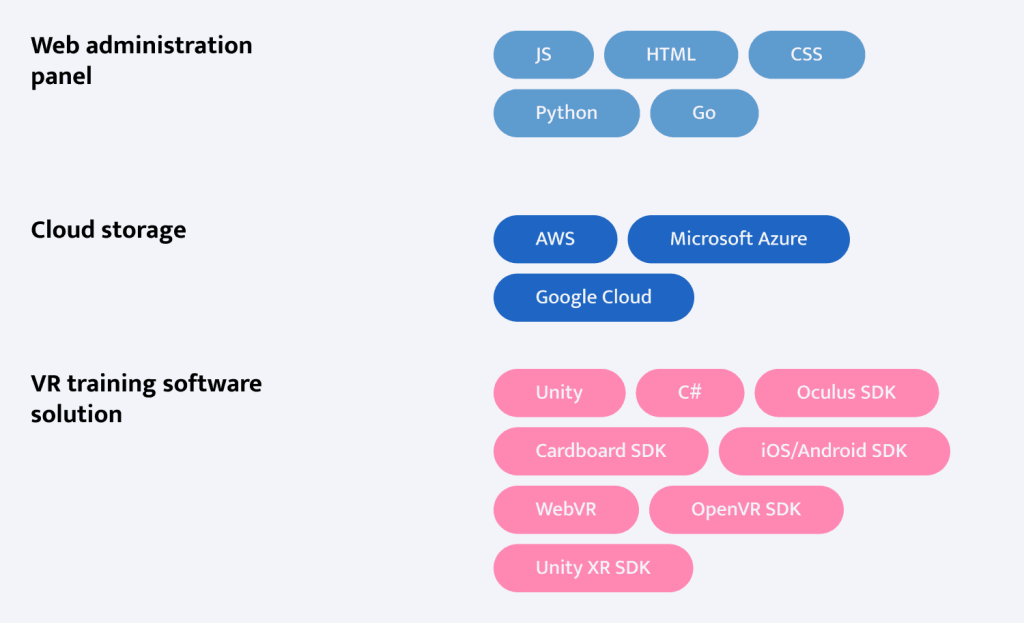
1. Hardware & Platforms: In order to create a successful and interactive virtual experience, hardware devices such as high-end gaming PCs and VR headsets need to be present. Additionally, these hardware solutions need to be supported by platforms such as Unity or Unreal Engine 4 in order to create a 3D environment.
2. Audio & Visuals: In order to deliver an immersive experience, audio and visuals have to be realistic and engaging. This includes creating high-quality textures, lighting effects, and soundscapes that are optimized for a wide range of devices. Additionally, the visuals need to be in sync with the audio and have full 360-degree tracking capabilities.
3. Software Development: The development of the VR Medical Training Software is largely dependent on the software used for creating it. This includes using scripting languages such as C#, C++ or Python, Java Script as well as software frameworks like React Native or AngularJS. Additionally, the developers will need to create interactive user interfaces and integrate APIs for data tracking.
4. User Experience Design: The development of the software should take into account the needs of the users. This includes incorporating features such as tutorials, guided lessons, and customizations that make it easier for users to understand and use the software effectively. Additionally, user testing should be conducted to ensure that the software is intuitive and user-friendly.
By investing in these four components of VR Medical Training Software, developers can create a solution that is both educational and entertaining for its users. This type of technology has the potential to revolutionize medical training and allow doctors and nurses to practice new techniques in a safe and immersive environment.
Virtual and Augmented Reality in Medical Training: Use Cases
How can virtual and augmented reality in medical education benefit patient care, which is crucial for the industry? Let’s take a closer look at VR in medical training.
At the very least, using AR and VR applications in medical training helps future doctors obtain more vital knowledge, thus providing more accurate diagnoses for their patients. Here are some real-life examples of how AR and VR technologies are already used in medical training.
Osso VR
Osso VR, a virtual reality training platform for medical professionals, has raised millions of dollars to help expand its mission of improving surgical outcomes and patient safety. It offers users a realistic, interactive experience by simulating surgeries in a three-dimensional environment. With its intuitive controls and intuitive navigation system, surgeons can easily practice and perfect their technique before entering the operating room for real. The system can also be used to educate medical students, allowing them to experience a simulation of an actual surgical procedure and understand the intricacies of the human body.
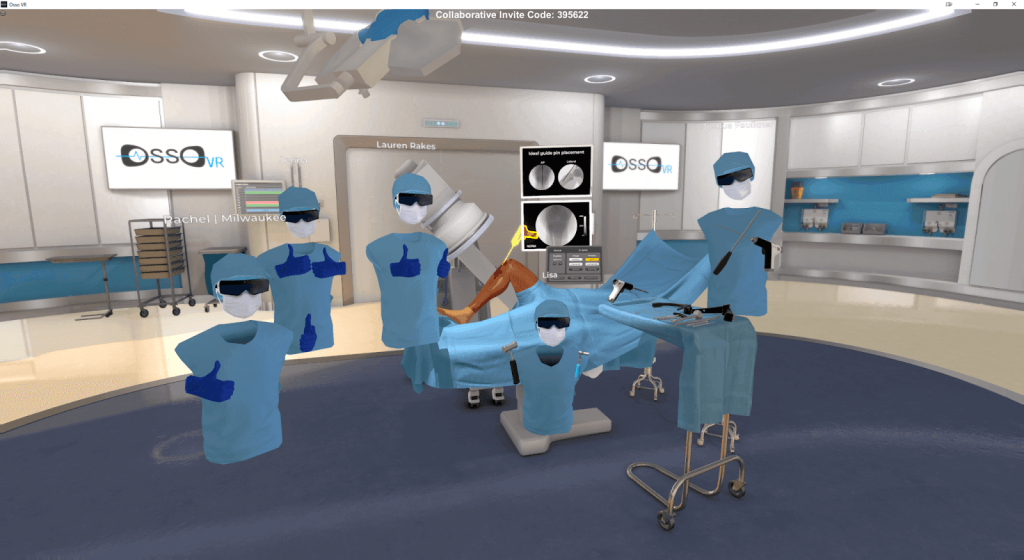
SimX
SimX is an advanced simulation platform that delivers comprehensive training for medical professionals such as physicians, nurses, health care administrators, and other health care providers. It provides users with realistic scenarios and challenges to help them learn new skills, improve their existing ones, and become better prepared for the clinical environment. The platform incorporates sophisticated 3D models of different human body parts and organs as well as virtual patients so that users can experience a realistic simulation.
Moreover, SimX has announced an expansion of its partnership with the United States Air Force. The collaboration will focus on using VR technology to create immersive, interactive training experiences for medical personnel.
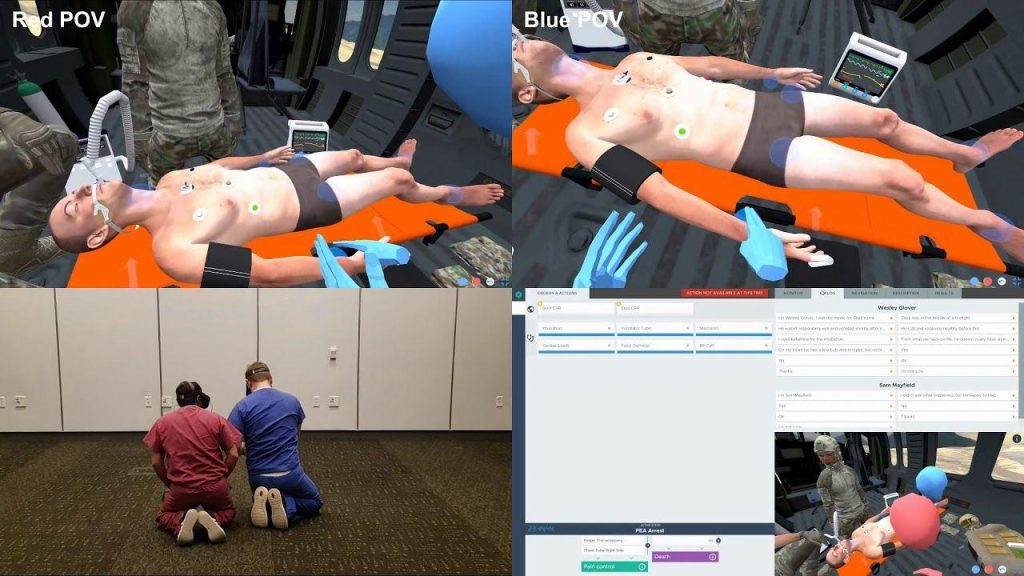
FundamentalVR
FundamentalVR was founded in 2012 in London. It was named one of Time Magazine’s best inventions for 2018 and received an Interactive Innovation Award at SXSW 2019.
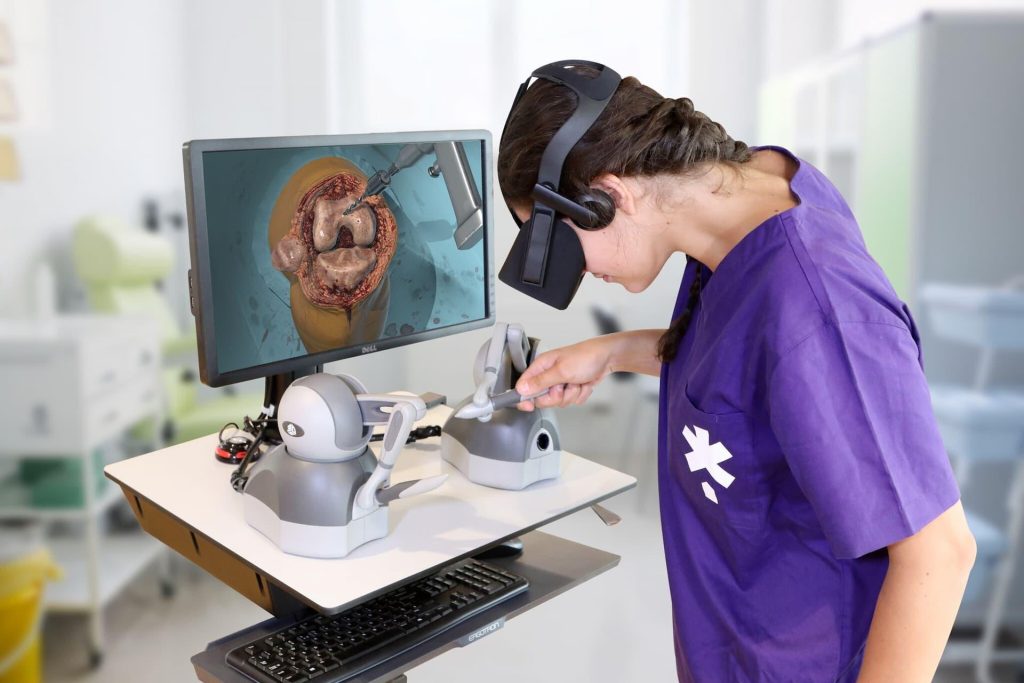
FundamentalVR offers simulator-based training programs for surgeons, with all its simulations being approved by the Royal College of Surgeons of England. The simulations are aimed at helping surgeons in training to rehearse and improve their techniques and skills by providing a safe, controlled virtual environment. It also has a tactile feedback feature.
Augmedics
Augmedics is a Chicago-based company founded in 2014. In March 2021, Augmedics raised $36M in oversubscribed Series C financing with an international syndicate of Israel-US investors.

Augmedics developed the first augmented reality (AR) navigation system aimed at being used in surgery and is called xvision. The technology projects a 3D representation onto the surgeon’s retina using a headset to see the patient’s anatomy through skin and tissue as if using X-ray vision. It helps the surgeon to attend to the patient and see the navigation data simultaneously. The system has demonstrated a 98.9% overall placement accuracy when tested on spinal screws in cadavers.
Health Scholars
Health Scholars was founded in Westminster, Colorado, in 2017. In January 2020, Health Scholars closed its $17M Series B to support further development and expansion of its VR content library.

Their VR training solutions are aimed to scale life-saving experiences through VR simulation powered by artificial intelligence (AI). Health Scholars’ VR simulations address emergency care training for adult and pediatric scenarios in various settings (e.g., pre-hospital or perioperative). Realistic and accurate visualizations help in mastering life-saving skills by delivering targeted virtual reality medical training.
HoloAnatomy by Microsoft
Another solution of Virtual Reality in medical education. HoloAnatomy app was developed in 2016 and won the 2016 Jackson Hole Wildlife Film Festival Science Media Awards. The app is free but was tailored to be used with the Microsoft HoloLens device.

It was the first AR healthcare educational application that provided students with a digitized, interactive anatomy curriculum. It uses mixed reality technology that assists in studying human anatomy with a high level of detail and interactivity. HoloAnatomy proved to provide an excellent value for medical students and practitioners by giving them seamless access to the tiniest details of the human body.
Improving Revenue Cycle With VR for Medical Education
The advances of VR in learning and training allow students and specialists to train more enjoyably and engagingly. New skills are acquired and honed through practice in interactive and safe virtual environments. Students don’t necessarily require an instructor because instructions and tips are built inside the VR app. Since VR is making medical learning almost as easy and effortless as a game and highly effective, the demand for VR-based solutions for healthcare is high. Implementing it can be very profitable for startups in terms of revenue while also providing a vital service to the medical community.
Medical schools can benefit from adopting augmented and virtual reality in medical devices and programs. For example, VR simulations provide the ability to explore the human body without endangering patients. A scarcity of subjects to practice on can often result in a situation where students could only practice once or twice before performing an actual surgical procedure. Virtual environments provide students with the valuable ability to explore, make mistakes, and learn from them. In addition, students can repeat these procedures multiple times.
In healthcare education, augmented and virtual reality doesn’t replace traditional training, but it provides a critical edge. It can present sophisticated concepts through visualization and interaction and provide a valuable view of real-world experiences. This makes tasks easier to grasp and creates a level of interest that textbooks or tests struggle to do.
To establish credibility, let’s turn to some benefits of virtual reality in medical education supported by research.

Cost-Effectiveness
Even though implementing VR applications in medical training requires somewhat costly hardware and software, it is still more cost-effective than a physical simulation of the same level of complexity. According to a study published in the Journal of Medical Internet Research, VR is 83% more cost-effective than high-fidelity mannequin-based simulation.

Performance Improvement
The vast majority of students who used VR technologies in their medical education stated that it enables faster work, enhances their performance, and boosts their motivation (supported by a study by Research Gate). Another survey by Research Gate states that VR training can scale up to any number of learners and improve overall performance by 250%.
Retention Enhancement
According to the Virtual and Augmented Reality in Education, Art, and Museums book, using VR in education makes it possible to reach a four times better retention rate than traditional educational methods. The book states that students of VR training retain 80% of the information after a year of training, while conventional methods showed only a 20% retention rate.
Reduced Number of Errors
According to research by Accenture, VR-trained surgeon students had 40% fewer mistakes than a similar group of students that trained using traditional methods. Additionally, the study by Springer Link shows that over 68% of students responded positively to using VR tutorials.
VR Learners are More Confident to Act on Acquired Knowledge
Virtual reality simulations in healthcare education allow students to train and rehearse their skills in immersive and low-stress environments, gaining more confidence when it comes to applying the acquired knowledge in real-life situations. As the PWC study shows, VR-trained students were up to 275% more confident to act on what they learned.
Medical device makers benefit from virtual environments as well. Instead of giving personal instructions or demonstrations to every specialist, they use VR to present their products. Although VR devices for medical training can be costly, each year, these companies are making this technology available to a broader audience by producing simpler headsets such as Oculus Go. The price points for these new devices are often cheaper than sending representatives to meet in person with clients.
Augmented Reality (AR) Is Also Suitable For Medical Training
Augmented reality overlays digital details on the physical world, producing real and digital environments. The increased usage of AR came along with innovations that made it available and applicable. It may not be as engaging as VR but can still yield outstanding results.
Today, AR applications are used in almost every stage of medical training, e.g., anatomical teaching tools, image training simulators, classroom study aids, and clinical skills interaction simulators. The advantages of augmented reality in medical training are:
- Students don’t need a VR helmet. They can hold a tablet over a manikin to superimpose simulated internal organs or a hologram of a patient on it. With AR, medical students and doctors can learn and practice anywhere, even at home, promoting continuous improvement.
- AR is not fully immersive, so it can combine real and virtual medical devices. For example, when students learn to read ultrasound images, AR would add layers with images of underlying tissue, blood vessels, nerves, muscles, and bones on the actual ultrasound image.
- Because AR is not fully immersive, it also makes teamwork possible. Team members can interact with one another and with the instructor.
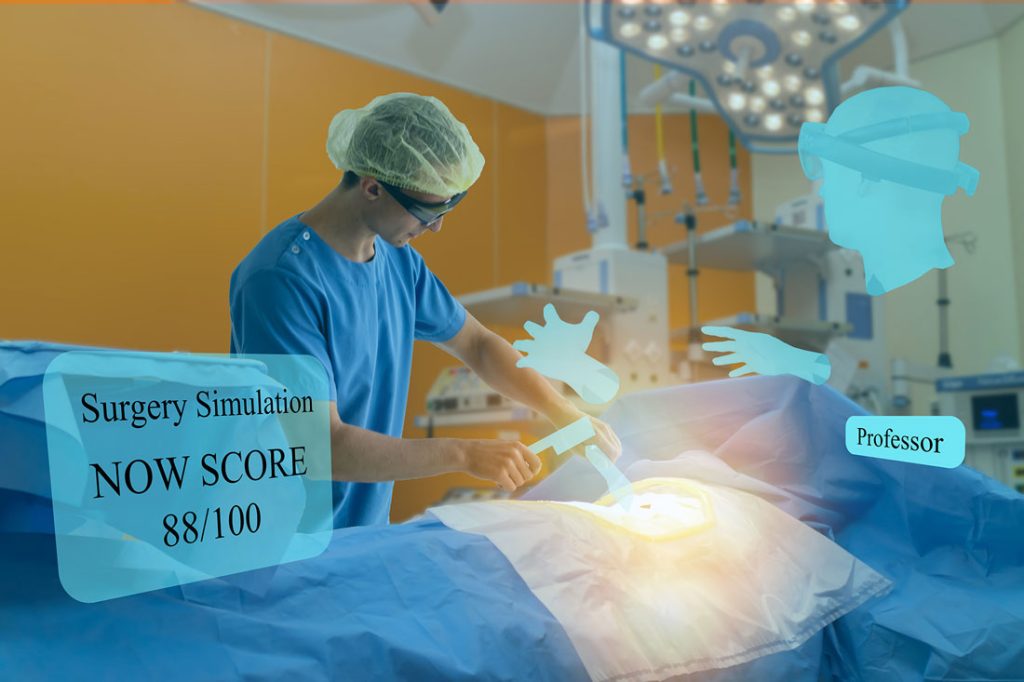
More so, AR can help anyone to become more knowledgeable about our bodies. For example, the UK-based company, Curiscope created a unique immersive learning experience using augmented reality. They developed the AR-enhanced T-shirt, which allows users to explore the body’s inner organs through realistic holograms. It is called Virtuali-tee, and it brings anatomy to life.
Approximate Cost of Implementing VR for Medical Education
The cost estimation for virtual reality training software development can vary greatly depending on the feature set, development rates, hardware required, and team size. A comprehensive cost analysis should factor in the resources necessary to complete all aspects of the project, from initial concept design and scripting to system integration, testing, deployment, and beyond.
Functionality
The features selected for the VR training software will influence the overall cost of development. Complex features such as 3D graphics capabilities or advanced animation sequences may require additional time and resources to develop, while simpler features like text-based tutorials could be done more quickly or with fewer resources. It is important to clarify what features are needed prior to starting development so that accurate costing can be done accordingly.
These are the basic elements used when constructing VR apps, though developers can add additional objects in accordance with specific needs.
- 3D environments to create a realistic background
- Animations to provide an engaging user experience
- Virtual characters
- Video and sound effects to make the training programs more lifelike
- Voice-overs to offer guidance throughout the session
Development Rates
Another factor that affects virtual reality training software development costs is the region where work is completed. Depending on the complexity of each feature set and how many developers are working on it at any given time, completion rates could vary significantly. For example, a larger team of experienced developers may finish a project much faster than a smaller team with less experience in specific technologies being used for the project’s development. Here is the table with development rates from different parts of the world:
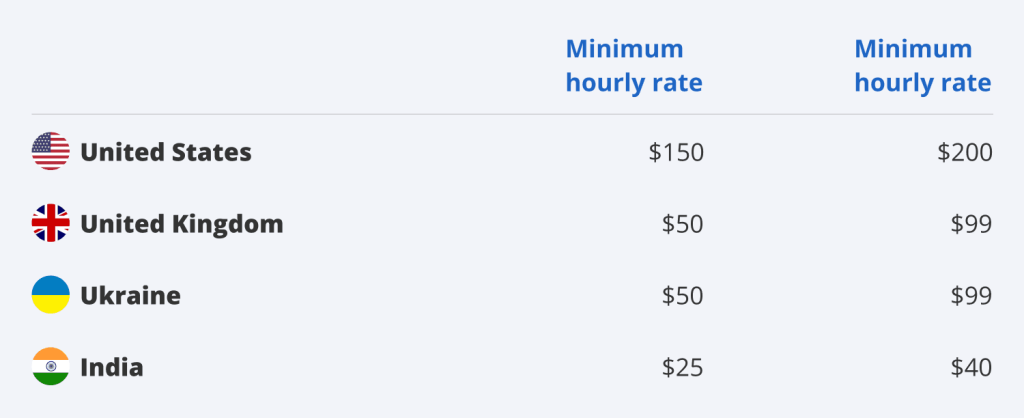
Hardware
Virtual reality training software requires compatible hardware in order for it to run properly. If specific hardware components are needed for certain features then these items must also be taken into account when doing a cost estimation. This includes items such as headsets, controllers or other peripherals that must be purchased in advance before development can begin. Additionally, if special infrastructure must be built such as servers or routers this too will add an extra layer of expense to any given project’s budgeting plan.
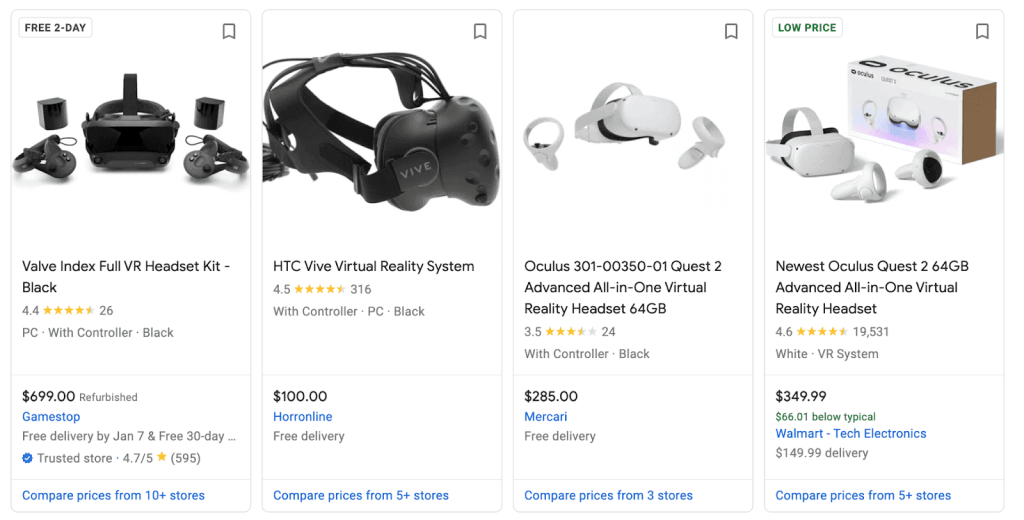
Team Size
The size of the team working on developing virtual reality training software will affect costs as well due to factors such as salaries, benefits, and other expenses associated with hiring personnel full-time or outsourcing outside services when necessary. Smaller teams will obviously incur lower costs but may not get projects finished on time if there isn’t enough manpower available for completing tasks efficiently and accurately; whereas larger teams may require additional funding but have better chances of finishing projects faster since there are more people present doing different pieces all at once within budget constraints established by management personnel prior to project start date(s).
Usually, building a VR training app requires a team that looks as follows:
- Project manager
- UX/UI designer
- Backend and frontend developers
- QA engineers
- 3D designer
- DevOps
Overall developing virtual reality training software requires careful consideration regarding feature sets desired by end users/customers; rates at which work should progress; hardware required; team size; plus other factors like budgeting plans & timelines so that accurate cost estimations can be made prior to starting any given project.
Alternative-spaces’ Experience in Developing VR for Medical Training
Our company has an established team of experienced AR/VR developers. They have created AR and VR applications for a variety of industries, from entertainment to construction. Alternative-spaces can provide you with an outstanding virtual reality system to further your hold on your target market and increase customer traffic.
As for experience developing virtual reality for medical education, the Alternative-spaces team has built several immersive and detailed VR applications. Some of them are:
- Laboratory VR Training Simulation is a digitized science lab providing hundreds of affordable experiments. It was created as a demonstration project that works on HTC Vive and Oculus Rift, with the main objective of introducing students to work in the laboratory.
- The VR Medical training prototype is designed for medical staff. In this project, immersive virtual reality technology created low-stress, safe, and interactive digital environments to provide immersive training opportunities.
Conclusion
Medical and especially surgical landscapes are evolving rapidly, and there is plenty of space for exploring new and experimental ways of training. VR and AR have great potential in the field. As they become more refined and accessible, the case for incorporating this technology into training programs seems to make sense.
VR technology has a long road ahead to become fully integrated with current curricula, but it is reasonable to predict that one day it will be a common practice. If you have innovative ideas on AR or VR for medical training or other fields, the Alternative-spaces team is here to help. Let’s pave the path for the future together.
FAQ
Why should the healthcare industry take AR and VR seriously?
Virtual and Augmented Reality provides limitless possibilities for the healthcare industry. Researchers and companies are coming up with different solutions and ideas on using these technologies to improve healthcare experiences ranging from equipment maintenance and medical training to surgeries support and patient’s hospital stay.
What is the current state of the AR and VR healthcare market?
AR and VR are emerging technologies in the healthcare industry. Both could be used in various settings, including physician training, patient treatments, and hospital management. As of 2018, the North American healthcare AR and VR industry was valued at $477M. By 2025, that is expected to increase dramatically to $4.64B.
How is VR being used in medical training?
With the ability to simulate real-life scenarios in a controlled environment, VR can be used to put healthcare professionals into complex medical situations without any health risks. It provides an ideal platform for practice and instruction, allowing medical teams to interact with virtual patients and hone their diagnostic and decision-making skills. Additionally, surgeons are able to get hands-on experience and practice techniques that would otherwise be impossible in the operating room, such as performing intricate surgeries or exploring organs and body systems from every angle.
Do doctors use VR to practice or only students?
VR technology is increasingly being adopted by both medical professionals and students. Medical practitioners are able to use it to practice and hone their skills in a safe, controlled environment, while medical students can benefit from its immersive capabilities to gain an understanding of complex medical procedures. Additionally, VR can be used to provide a more engaging learning environment for students and help them retain information faster and more efficiently.
How much does it cost to implement AR for medical education?
The cost of implementing AR or VR for medical education depends on the type and complexity of the system. Generally speaking, creating a basic setup with pre-existing software can cost anywhere from a few hundred to several thousand dollars. However, for more complex and customized setups, such as those used for medical simulation training, costs can be much higher and require an entire team of experienced professionals. Additionally, software and hardware must both be purchased in order to create a complete system.
Content created by our partner, Onix-systems.
Source: https://onix-systems.com/blog/implementing-virtual-reality-in-medicine-and-medical-training Home
Home